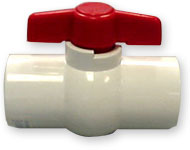Difference between revisions of "Ball valve"
(linkage) |
MCRKilljoy (talk | contribs) |
||
| (5 intermediate revisions by 4 users not shown) | |||
| Line 1: | Line 1: | ||
| − | [[Image:Ball_valve.jpg|frame|A typical PVC ball valve]] | + | [[Image:Wballvalve.png|frame|Cross-section of typical ball valve; A is barrel, B is ball, C is handle (not actually in the plane of the cut), D is chamber]] |
| − | '''Ball valves''' open with a 90* twist of lever, similar to the operation of a [[butterfly valve]]. They are about the cheapest valve you can get, but also (typically) yield the worst performance, due to the slow [[opening time]]. | + | [[Image:Ball_valve.jpg|frame|A photo of a typical PVC ball valve]] |
| − | The flow of a ball valve, however, is quite good due to its straight-through nature. This will tend to even out the situation in cannons with very long | + | '''Ball valves''' open with a 90* twist of lever, similar to the operation of a [[butterfly valve]]. They are about the cheapest [[valve]] you can get, but also (typically) yield the worst performance, due to the slow [[opening time]]. |
| + | The flow of a ball valve, however, is quite good due to its straight-through nature. This will tend to even out the situation in cannons with very long [[barrel]]s and/or heavy projectiles (and thus long barrel dwell times). Ball valves are also used to isolate parts of a launcher, for example, when filling with a male [[quick disconnect]] to stop air from escaping. [[Gate valve|Gate valves]] can be used here too. | ||
Opening time can be shortened by: | Opening time can be shortened by: | ||
| Line 7: | Line 8: | ||
* Applying dish soap or other lubricant to the moving part. Oil or oil based lubricants should ''not'' be used, because they can damage the seals. Lubricating the ball valve will decrease friction and will result in a faster opening time. | * Applying dish soap or other lubricant to the moving part. Oil or oil based lubricants should ''not'' be used, because they can damage the seals. Lubricating the ball valve will decrease friction and will result in a faster opening time. | ||
| − | However, there is more performance to be gained by using a faster valve, such as a | + | However, there is more performance to be gained by using a faster valve, such as a butterfly valve, [[piston valve|piston]] or [[diaphragm valve]], or a [[burst disk]]. |
| + | |||
| + | It is possible to achieve extremely low opening times with ball valves through somewhat unconventional methods. Unfortunately, to open in the time necessary to make it a practical valve, a rather large amount of energy must be applied - so much, in fact, that in the lone test this was actually tried, the kinetic energy of the handle completely demolished the valve, and the ram was never recovered. This only serves to prove that you really are better off with a faster valve. | ||
[[category:valves]] | [[category:valves]] | ||
Latest revision as of 00:38, 9 December 2016
Ball valves open with a 90* twist of lever, similar to the operation of a butterfly valve. They are about the cheapest valve you can get, but also (typically) yield the worst performance, due to the slow opening time. The flow of a ball valve, however, is quite good due to its straight-through nature. This will tend to even out the situation in cannons with very long barrels and/or heavy projectiles (and thus long barrel dwell times). Ball valves are also used to isolate parts of a launcher, for example, when filling with a male quick disconnect to stop air from escaping. Gate valves can be used here too.
Opening time can be shortened by:
- Using a spring or a pneumatic ram to actuate the valve
- Applying dish soap or other lubricant to the moving part. Oil or oil based lubricants should not be used, because they can damage the seals. Lubricating the ball valve will decrease friction and will result in a faster opening time.
However, there is more performance to be gained by using a faster valve, such as a butterfly valve, piston or diaphragm valve, or a burst disk.
It is possible to achieve extremely low opening times with ball valves through somewhat unconventional methods. Unfortunately, to open in the time necessary to make it a practical valve, a rather large amount of energy must be applied - so much, in fact, that in the lone test this was actually tried, the kinetic energy of the handle completely demolished the valve, and the ram was never recovered. This only serves to prove that you really are better off with a faster valve.

